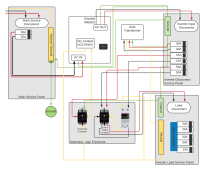Desert_AIP
New Member
- Joined
- Apr 5, 2020
- Messages
- 67
One caution,
I don't see a voltage or amperage rating for the dry contact in the specs sheet or manual.
The amperage needed to activate the coil is likely a few (or hundred) milliamps, so probably not a problem.
Voltage limit of the contacts is unknown.
Is the side of the contact accessible to read the specs or part number off of the module itself?
I don't see a voltage or amperage rating for the dry contact in the specs sheet or manual.
The amperage needed to activate the coil is likely a few (or hundred) milliamps, so probably not a problem.
Voltage limit of the contacts is unknown.
Is the side of the contact accessible to read the specs or part number off of the module itself?






